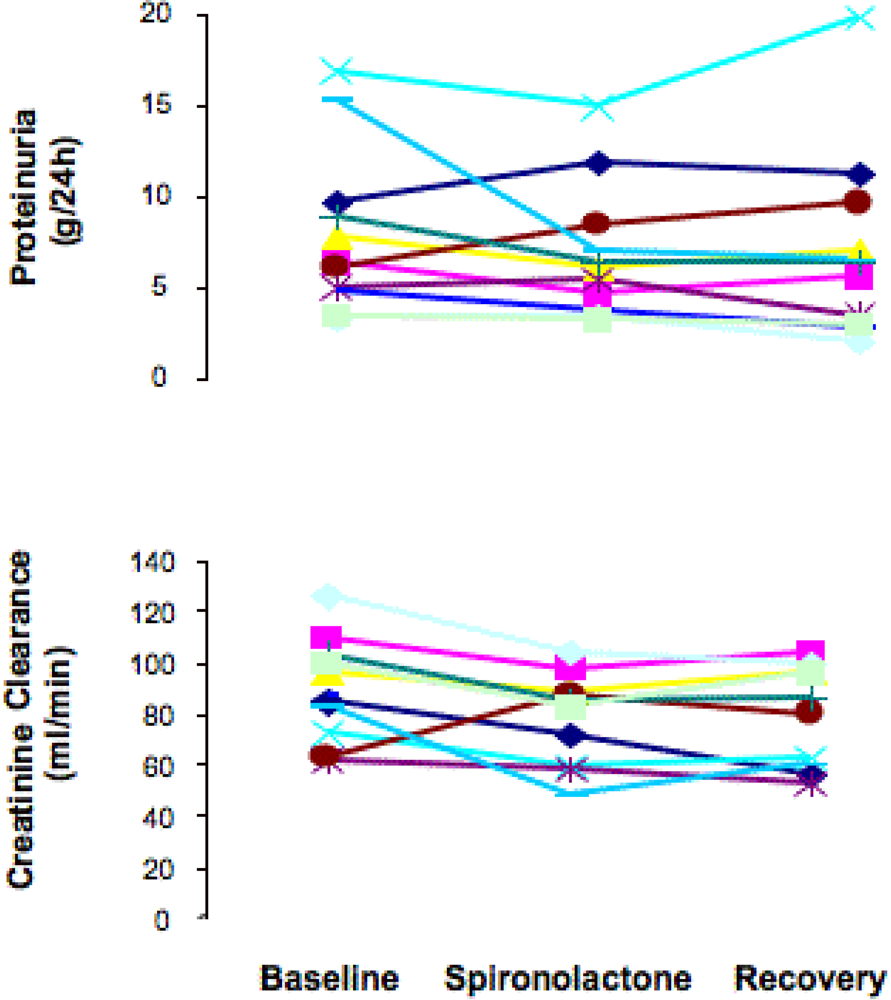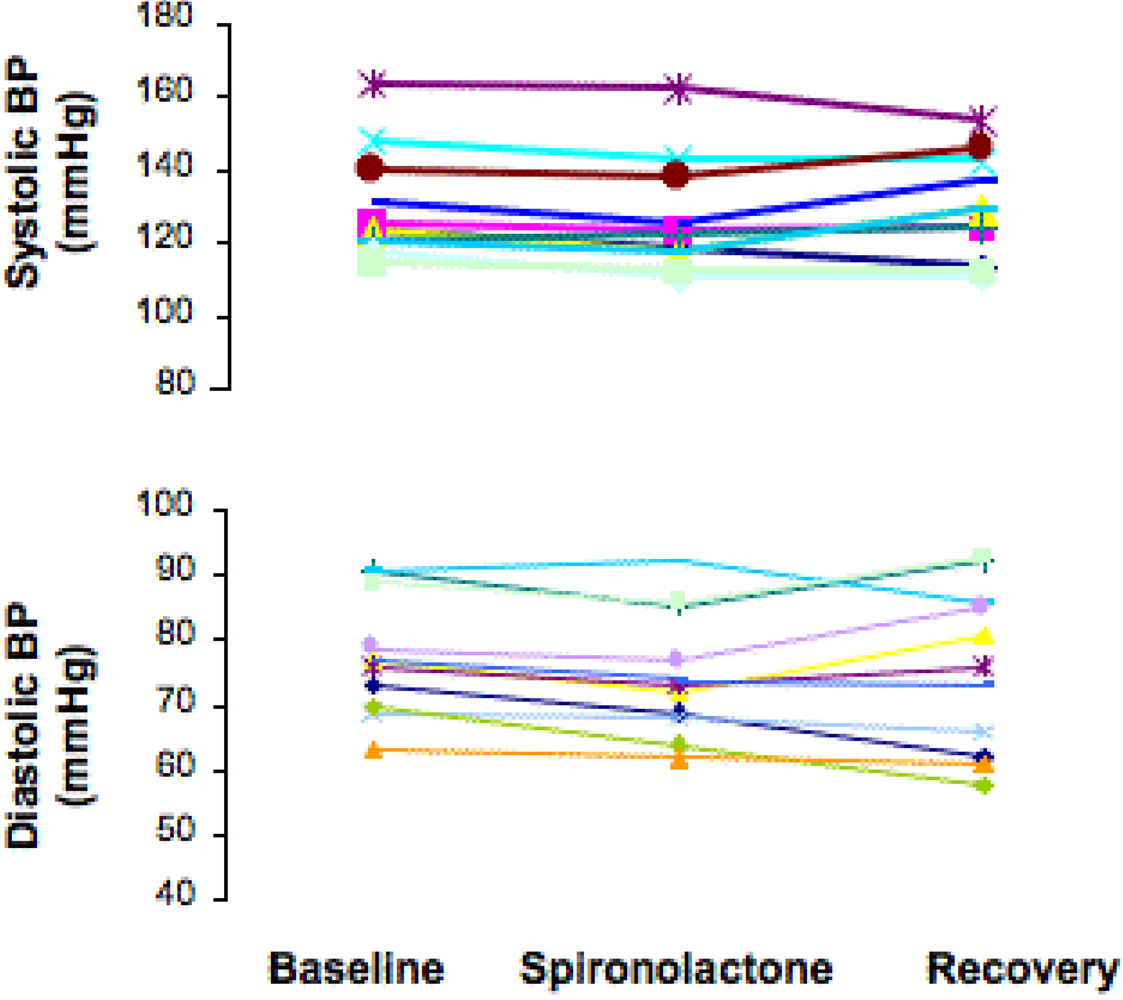Spironolactone Plus Full-Dose ACE Inhibition in Patients with Idiopathic Membranous Nephropathy and Nephrotic Syndrome: Does It Really Work?
Abstract
:1. Introduction
2. Results and Discussion
2.1. Patient characteristics and treatment
2.2. Baseline and outcome data
| Baseline | Spironolactone | Recovery | |
|---|---|---|---|
| Systolic blood pressure (mmHg) | 129.5 ± 15 | 126.1 ± 15.6* | 129.1 ± 14.2 |
| Diastolic blood pressure (mmHg) | 77.7 ± 9.27 | 74.7 ± 9.5* | 75.7 ± 12.7 |
| Mean arterial pressure (mmHg) | 95.2 ± 10.6 | 92 ± 11.4* | 94 ± 13.1 |
| Weight (Kg) | 69.3 ± 17.1 | 68.8 ± 15.5 | 69.7 ± 16.7 |
| 24 hour proteinuria (g/24 hour) | 7.9 ± 4.5 | 6.8 ± 3.7 | 7.0 ± 5.1 |
| U P/C | 7.2 ± 4.8 | 6.5 ± 4 | 6.9 ± 5.2 |
| 24 hour albuminuria (mg/24 hour) | 3790 ± 2381 | 3329 ± 2113 | 3116 ± 2289 |
| 24 hour Urinary potassium (mEq/24 hour) | 53.8 ± 13.1 | 49.5 ± 16.1 | 51.3 ± 13.4 |
| Urinary sodium (mEq/24 hour) | 148 ± 32.6 | 159 ± 36.6 | 148 ± 34.3 |
| CrCl (ml/min) | 94.83 ± 25.7 | 80.32 ± 18.9** | 85.19 ± 27** |
| Serum creatinine (mg/dL) | 0.99 ± 0.1 | 1.10 ± 0.2 | 1.08 ± 0.2 |
| Potassium (mEq/L) | 4.4 ± 0.4 | 4.6 ± 0.4* | 4.3 ± 0.3* |
| Serum albumin (g/dL) | 2.27 ± 0.5 | 2.44 ± 0.5** | 2.44 ± 0.5** |
| Serum protein (g/dL) | 4.46 ± 0.6 | 4.77 ± 0.7** | 4.74 ± 0.7** |
| Total cholesterol (mg/dL) | 291.3 ± 102.5 | 276.2 ± 112.3 | 263.2 ± 80.9** |
| LDL-cholesterol (mg/dL) | 201 ± 90.3 | 180.8 ± 63.4 | 184.1 ± 69.7 |
| HDL-cholesterol (mg/dL) | 63.1 ± 8.9 | 53.8 ± 10.2 | 50.4 ± 7.6 |
| Triglycerides (mg/dL) | 136.5 ± 56.2 | 140.5 ± 75.4 | 147.7 ± 56.5 |


2.3. Discussion
3. Experimental Section
3.1. Patient Selection
3.2. Treatment
3.3. Sample size
3.4. Statistical analysis
4. Conclusions
References and Notes
- Hostetter, T.H.; Ibrahim, H.N. Aldosterone in chronic kidney and cardiac disease. J. Am. Soc. Nephrol. 2003, 14, 2395–2401. [Google Scholar] [CrossRef] [PubMed]
- Epstein, M. Aldosterone receptor blockade and the role of eplerenone: evolving perspectives. Nephrol. Dial. Transplant 2003, 18, 1984–1992. [Google Scholar] [CrossRef] [PubMed]
- Greene, E.L.; Kren, S.; Hostetter, T.H. Role of aldosterone in the remnant kidney model in the rat. J. Clin. Invest. 1996, 98, 1063–1068. [Google Scholar] [CrossRef] [PubMed]
- Quan, Z.Y.; Walser, M.; Hill, G.S. Adrenalectomy ameliorates ablative nephropathy in the rat independently of corticosterone maintenance level. Kidney Int. 1992, 41, 326–333. [Google Scholar] [CrossRef] [PubMed]
- Rocha, R.; Chander, P.N.; Zuckerman, A.; Stier Jr., C.T. Role of aldosterone in renal vascular injury in stroke-prone hypertensive rats . Hypertension 1999, 33, 232–237. [Google Scholar] [PubMed]
- Chrysostomou, A.; Becker, G. Spironolactone in addition to ACE inhibition to reduce proteinuria in patients with chronic renal disease. N. Engl. J. Med. 2001, 345, 925–926. [Google Scholar] [CrossRef] [PubMed]
- Rachmani, R.; Slavachevsky, I.; Amit, M.; Levi, Z.; Kedar, Y.; Berla, M.; Ravid, M. The effect of spironolactone, cilazapril and their combination on albuminuria in patients with hypertension and diabetic nephropathy is independent of blood pressure reduction: a randomized controlled study. Diabet. Med. 2004, 21, 471–475. [Google Scholar] [CrossRef] [PubMed]
- Navaneethan, S.D.; Nigwekar, S.U.; Sehgal, A.R.; Strippoli, G.F. Aldosterone antagonists for preventing the progression of chronic kidney disease: a systematic review and meta-analysis. Clin. J. Am. Soc. Nephrol. 2009, 4, 542–551. [Google Scholar] [CrossRef]
- Ruggenenti, P.; Chiurchiu, C.; Brusegan, V.; Abbate, M.; Perna, A.; Filippi, C.; Remuzzi, G. Rituximab in idiopathic membranous nephropathy: a one-year prospective study. J. Am. Soc. Nephrol. 2003, 14, 1851–1857. [Google Scholar] [CrossRef] [PubMed]
- Sato, A.; Saruta, T. Aldosterone escape during angiotensin-converting enzyme inhibitor therapy in essential hypertensive patients with left ventricular hypertrophy. J. Int. Med. Res. 2001, 29, 13–21. [Google Scholar] [PubMed]
- Sato, A.; Hayashi, K.; Naruse, M.; Saruta, T. Effectiveness of aldosterone blockade in patients with diabetic nephropathy. Hypertension 2003, 41, 64–68. [Google Scholar] [CrossRef] [PubMed]
- Epstein, M.; Williams, G.H.; Weinberger, M.; Lewin, A.; Krause, S.; Mukherjee, R.; Patni, R.; Beckerman, B. Selective aldosterone blockade with eplerenone reduces albuminuria in patients with type 2 diabetes. Clin. J. Am. Soc. Nephrol. 2006, 1, 940–951. [Google Scholar] [CrossRef]
- Schjoedt, K.J.; Andersen, S.; Rossing, P.; Tarnow, L.; Parving, H.H. Aldosterone escape during blockade of the renin-angiotensin-aldosterone system in diabetic nephropathy is associated with enhanced decline in glomerular filtration rate. Diabetologia 2004, 47, 1936–1939. [Google Scholar] [CrossRef] [PubMed]
- Navaneethan, S.D.; Nigwekar, S.U.; Sehgal, A.R.; Strippoli, G.F. Aldosterone antagonists for preventing the progression of chronic kidney disease . Cochrane Database Syst. Rev. 2009, CD007004. [Google Scholar]
- Buter, H.; Hemmelder, M.H.; Navis, G.; de Jong, P.E.; de Zeeuw, D. The blunting of the antiproteinuric efficacy of ACE inhibition by high sodium intake can be restored by hydrochlorothiazide. Nephrol. Dial. Transplant 1998, 13, 1682–1685. [Google Scholar] [CrossRef] [PubMed]
- Schepkens, H.; Vanholder, R.; Billiouw, J.M.; Lameire, N. Life-threatening hyperkalemia during combined therapy with angiotensin-converting enzyme inhibitors and spironolactone: an analysis of 25 cases. Am. J. Med. 2001, 110, 438–441. [Google Scholar] [CrossRef] [PubMed]
- Juurlink, D.N.; Mamdani, M.M.; Lee, D.S.; Kopp, A.; Austin, P.C.; Laupacis, A.; Redelmeier, D.A. Rates of hyperkalemia after publication of the Randomized Aldactone Evaluation Study. N. Engl. J. Med. 2004, 351, 543–551. [Google Scholar] [CrossRef] [PubMed]
- Cravedi, P.; Ruggenenti, P.; Remuzzi, G. Intensified inhibition of renin-angiotensin system: a way to improve renal protection? Curr. Hypertens. Rep. 2007, 9, 430–436. [Google Scholar] [CrossRef]
© 2010 by the authors; licensee Molecular Diversity Preservation International, Basel, Switzerland. This article is an open access article distributed under the terms and conditions of the Creative Commons Attribution license (http://creativecommons.org/licenses/by/3.0/).
Share and Cite
Cravedi, P.; Brusegan, V.; Ruggenenti, P.; Campbell, R.; Remuzzi, G. Spironolactone Plus Full-Dose ACE Inhibition in Patients with Idiopathic Membranous Nephropathy and Nephrotic Syndrome: Does It Really Work? Pharmaceuticals 2010, 3, 1-9. https://doi.org/10.3390/ph3010001
Cravedi P, Brusegan V, Ruggenenti P, Campbell R, Remuzzi G. Spironolactone Plus Full-Dose ACE Inhibition in Patients with Idiopathic Membranous Nephropathy and Nephrotic Syndrome: Does It Really Work? Pharmaceuticals. 2010; 3(1):1-9. https://doi.org/10.3390/ph3010001
Chicago/Turabian StyleCravedi, Paolo, Varusca Brusegan, Piero Ruggenenti, Ruth Campbell, and Giuseppe Remuzzi. 2010. "Spironolactone Plus Full-Dose ACE Inhibition in Patients with Idiopathic Membranous Nephropathy and Nephrotic Syndrome: Does It Really Work?" Pharmaceuticals 3, no. 1: 1-9. https://doi.org/10.3390/ph3010001
APA StyleCravedi, P., Brusegan, V., Ruggenenti, P., Campbell, R., & Remuzzi, G. (2010). Spironolactone Plus Full-Dose ACE Inhibition in Patients with Idiopathic Membranous Nephropathy and Nephrotic Syndrome: Does It Really Work? Pharmaceuticals, 3(1), 1-9. https://doi.org/10.3390/ph3010001




